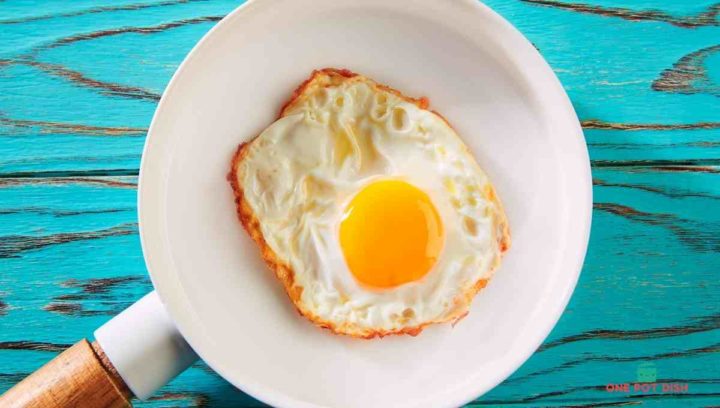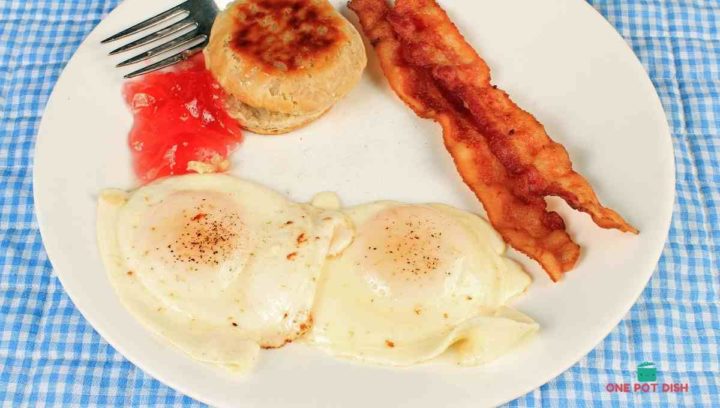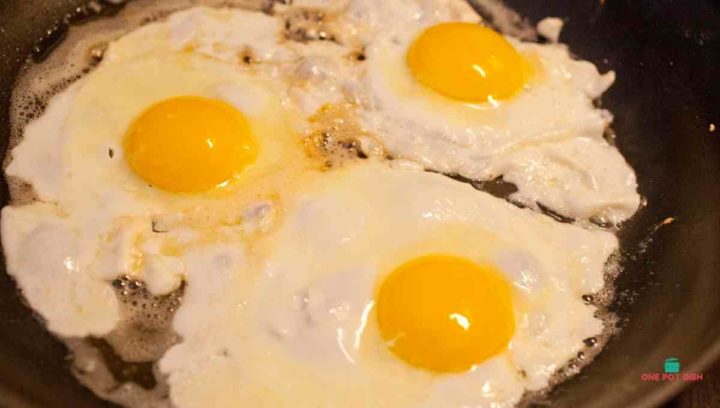Eggs are a staple food around the globe. They are also a great source of protein. But did you know that many people are still trying to figure out how to cook it without breaking the yolk?
This article will show you how to flip an egg without breaking the yolk.
We have discovered a clever method to assist with flipping. It also includes all of the elements required to get the eggs to turn out correctly. Although your first one may not be perfect, we assure you will be able to do it after learning these things.
This is a new egg hack that we have never seen before, so we might call it an egg hack for fun. It is not difficult, but it makes flipping easier. Do not worry. The trick will be discussed in a moment.
Let us begin by getting the rest of the egg cooked properly so that you are ready to flip it without breaking the yolk.
Step 1: Heat The Pan Over Low-Medium Heat
Remember, do not overcook your eggs. I generally just set my stovetop to the lowest temperature, but go higher if you’re feeling more confident. The ideal range is around 210°F to 260°F. As you cook, the pan will build heat. However, keep it under 300°F by a considerable amount.

Just a hint: infrared thermometers are helpful in almost every kitchen activity.
Step 2: Add Butter or Cooking Spray As Needed
I discovered that using butter or cooking spray for over-easy eggs is a good idea because oil adds additional liquid to the mix. When you overheat oil, it splatters and creates a mess. However, oils may be useful in certain situations; just keep in mind that you don’t require much of it.

If you do not have a thermometer, adding butter lets you check the pans’ temperature. The butter should not foam up but rather melt gradually.
Step 3: Crack The Egg On A Flat Surface
All egg styles are affected. When cracking the eggs, don’t do it on the side of a pan. Crack them on a flat surface, such as your countertop. This will assist in minimizing any unwanted broken yolks and shells getting into the mix early on and reduce the chances of any pesky shells getting in there.
Keeping your eggs cool may help them crack. We usually give the egg three taps down on the counter. To form a longer crack, one tap in the middle and two more on each side.
Step 4: Cook The Eggs On Low Heat
Again, we find that cooking the eggs slowly is superior. Instead of speeding up the process, I prefer to cook them low and slow. It still takes a while to prepare them, regardless. So once you’ve cracked open your egg and are ready to pour the yolk into the pan. Carefully separate but rapidly dump the eggs with both hands.
This step does take some practice, and there is a technique to it. However, you do not want to break the yolk at this point, so it is not too difficult to mess up.
After adding the egg, cook for 3-4 minutes. Allow the yolk’s liquid to turn white around it. You are ready to use the egg hack now.
Step 5: Flipping Trick
For the flip, I have discovered that using a trick or hack makes the process much simpler. As a result, near the yolk of your egg is a thinner egg white section. Before you turn the egg, I recommend eliminating these sections. Use a plastic spatula to avoid scratching your pan and run it along the edges, trimming off any thinner egg white sections. They will usually become overcooked in any case.
A chicken egg has been formed. Nothing more needs to be done, and the egg is ready to be turned. Because the form is rounded out, it is far easier to flip.

Step 6: Flip Your Egg
Now you are ready for the daunting flipping procedure. I discovered that flipping the pan was much easier than using a spatula with a little practice. At the very least, for maintaining the egg yolk from shattering.
Step 7: Continue Cooking
The final stage in the cooking procedure. You may now select how well-done you want your over-easy eggs to be. Let it cook for up to a minute if you desire them truly over easy. Maybe even just a few seconds would do the trick. The egg yolk will be runny as a result of this process.
Step 8: Serve
You are ready to eat and serve your eggs once they have cooled. I overcooked my egg, but there is still some runny yolk left.
Other Ways In Cooking Eggs
They must be as fresh as possible, with only a few basic ingredients. The older the eggs are, the delicate the whites become, and the more likely the yolk will fall out. On the other hand, fresh eggs are always better when it comes to obtaining the best taste, texture, and presentation.
For example, to make poached, scrambled, sunny-side up, and over-easy eggs, you will need to crack a few eggs.
Over Easy, Medium, and Hard Cooking
Perfectly cooked eggs require the same cooking technique and ingredients in this category. It is critical to use enough fat, maintain a consistent temperature, and have steady hands when preparing these dishes. Most importantly, you don’t want to shatter that delicious creamy yolk until it’s time to consume it.
The length of time the egg remains cooked after being flipped is the only distinction between these three styles. Over easy, for example, requires another 20-30 seconds to cook for a total of 1 minute, while over medium takes 1 minute longer and over hard 2 minutes more.
Clarified butter is often used for cooking eggs. Clarified butter is produced by heating whole butter until the milk solids and water are removed, allowing for higher cooking temperatures. Unsalted butter should always be used, so you control the dish’s saltiness.
A nonstick pan may be used instead. Fat should be added to the pan for taste and lubrication, whether it is a traditional or nonstick pan.
If you are making a fried egg sandwich, cook the eggs over medium heat. If the heat is too low, the eggs might adhere to the pan, and if it’s too high, they will burn. The last step is the most nerve-wracking portion of the flip. This is when everything comes down to flawless execution. Do not break that yolk. If you’re sure about your flipping abilities, lift the pan off the burner, turn it upside down, and swirl it around before flicking your wrist slowly to complete the flip.
A spatula may also be used to flip the egg. Scoop underneath the egg and carefully place it on your spatula. Then, with a little bit of care, turn it over onto its other side back into the pan. There should be no broken yolk, and the egg will be perfectly cooked if everything goes well.
Flipping An Egg Without a Spatula
If you are not up for the wrist flip or spatula flip, do not worry; you have alternatives. One alternative is to baste the eggs in cooking fat until they are done. The alternate option is to fill a pan with water and cook them covered until they reach the desired doneness.
You should practice if you want to wow all of your pals and relatives with your spatula-free flipping abilities. The simplest method is with a slice of toast in a sauté pan. If you are having trouble flipping a piece of bread, try holding the pan in one hand while the toast is inside. Flip the toast as many times as necessary to learn how much wrist movement is required.
Sunny side Up (not flipped)
The sunny side up egg is merely similar to the over-style eggs, with identical cooking techniques and substances. The only distinction is that there isn’t a flip required.
Poached
To make poached eggs, you need to gently place your eggs in salted boiling water and simmer them very slowly until the egg whites firm up and hold their form. Eggs Benedict is a classic dish wherein poached eggs are utilized.
To avoid any ugly or damaged yolks, crack the eggs into mixing bowls and add them to the simmering water.
The more fresh eggs you have, the less their white surfaces spread out before thickening, and your final product will be better.
Add some white distilled vinegar to the simmering water and swirl the water around like a tornado before carefully adding the eggs. The vinegar and the water’s swirling motion will assist in shaping the poached egg into a tidy package.
Scrambled
Here is your chance to break some perfect eggs. There are a few methods for preparing scrambled eggs. Stirring your eggs over low heat will result in a more runny, airy texture and delicate flavor, but you must stir them constantly while they cook if you want them softer and creamier. Stirring less frequently produces firmer eggs.
Before placing the eggs in the pan, you may use a fork or whisk to blend them until smooth. You may also add your salt and pepper at this point. If any moisture leaks from the eggs, this is a clear sign that your final product has been overcooked.
Add any of your favorite unsweetened dairy-free ingredients, such as milk, heavy cream, or alternative kinds of milk like coconut. Water is also a good choice for light and fluffy scrambled eggs.